Secular curriculum that makes you think *
Secular curriculum that makes you think *

High school is all about forming your own ideas, developing arguments, and asking big questions.
We help you grow the skills you need with rigorous, student-led secular curriculum. (Real science, real history, no whitewashing.)
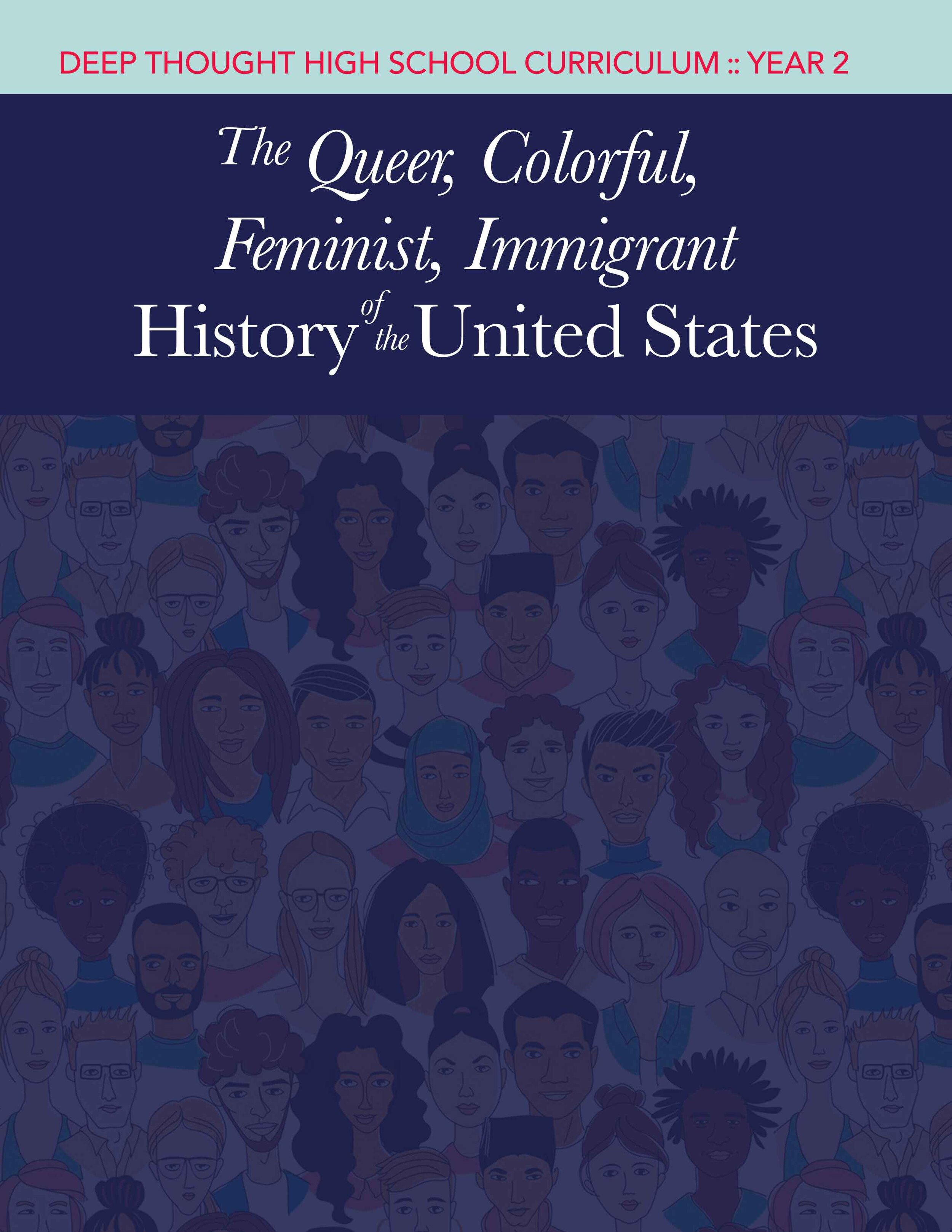
This is a digital product. It will be delivered via email as a PDF.
Our YEAR 2 curriculum focuses on the history, literature, philosophy, and geography of the United States, with the intention to amplify the stories of historically marginalized voices, including women, POC, LGBTQ+ people, and immigrants. Chemistry, which is roughly the same age as the United States, and which has experienced many of the same growth spurts and growing pains because of this, felt like the right science for this year’s studies.
This is not a reading guide; it is a complete 28-week (400+-page) curriculum, including lessons, assignments, exams, lectures, and supplemental materials. It also includes strategies for planning, goal-setting, and evaluating (and assigning grades for) work. It is designed for the Academy’s two 14-week semesters, but I’ve included suggestions for adapting the pace for your particular homeschool. This curriculum is written for the student; there is no parent guide. (If you have questions or need support, please feel free to contact me!)
INCLUDES:
American Literature (Units: Emily Dickinson, The Awakening, American Gothic, William Carlos Williams, the Harlem Renaissance, We Have Always Lived in the Castle)
U.S. History
Philosophy(Transcendentalism)
Chemistry
Government
Includes weekly student planner and goal setter
Add your own math and foreign language, and you’re all set!
In addition to this curriculum package, you will need to purchase or otherwise procure copies of: The Disappearing Spoon, The Awakening, and We Have Always Lived in the Castle. All other required readings are included in this curriculum.
This is a high school level curriculum, designed for students who are already familiar with the basic elements of literature (plot, character, theme, setting, etc.) and who are comfortable applying those skills to texts. Like most high school level curricula, it includes works that could be rated M for Mature. If mature content is a concern for you with your student, I encourage you to preview texts to asses your personal comfort level. (I read these texts with my own high school student and teach them in high school classes, but comfort levels can be very personal things.) This is a completely secular program.
With both print and digital curriculum, primary source documents and other readings are included in the curriculum. Please see the sample curriculum pages to see how this looks!
You will need to provide supplies for your science labs — we’ve included a list for each one. To use online lectures and materials, you will need access to a computer and the internet.
You do not need to use this curriculum in order. If you want to start with the curriculum we call Year 3, you can absolutely use that for your first year. Our curriculum is set up so that your grades and evaluations reflect student progress — that means you’re interested in how your student grows and develops as a learner from year to year instead of focusing on arbitrary metrics.
You should be aware: No curriculum is unbiased, but ours is intentionally progressive. We believe in decolonizing the curriculum, and our program is unapologetically against racism, sexism, homophobia, xenophobia, and othering in all its forms. There may have been a time when curriculum could be neutral, but to be neutral within these systems is to support oppression — and we cannot do that. If you want a curriculum that presents the “other side” of things like evolution or sexism, we are probably not the best choice for your homeschool.
Because of the nature of digital publications, all sales are final. If you have questions, please ask before you buy!
What's inside this literature unit:
Full, annotated-by-Amy texts of "The Vampyre," Dracula, and Carmilla (that makes this a HUGE file, so check the page count before you print it out!)
Discussion questions to guide you through each text
Introductory reading notes on Gothic literature, the origin of the vampire story, and each text
Final project essay
Bonus: Comparative lit movies for each text

This is a digital product. It will be delivered via email as a PDF.
Ready to tackle the OTHER side of U.S. history? This year-long high school U.S. history curriculum is a self-paced version of Deep Thought curriculum, designed for students who want to work mostly independently.
Over the course of 24 deep-dive lessons, students will look at the history of the United States through the experiences of non-cis-straight-white men, from anti-Mexican sentiment in the California Gold Rush to the woman behind the administration of Prohibition to the Stonewall uprising. Students will work through guided research questions, read (included) essays about historical figures, analyze (included) primary source documents, and develop their own historical arguments. Major output includes DBQ essays, a local history project, and a history biography project.
This is a high school level unit, designed for students who are already familiar with the basic elements of critical reading and annotation. Like most high school level curricula, it includes works that could be rated M for Mature. If mature content is a concern for you with your student, I encourage you to preview texts to assess your personal comfort level. (I read these texts with my own high school student and teach them in high school classes, but comfort levels can be very personal things.) This is a completely secular program.
Because of the nature of digital publications, all sales are final. If you have questions, please ask before you buy!
“All Japanese stories are ghost stories.”
That’s the Big Idea behind this literature unit and the theme we’ll keep coming back to as we explore some of (in my opinion!) the most interesting works of Japanese literature. These works span centuries — some are quite recent, some are more ancient than Chaucer’s Canterbury Tales — but they have in common the notion that our everyday world is “haunted.” (I put haunted in quotation marks because — as we’ll see over the course of this unit — hauntings can take many forms.)
Credit recommendation: 0.5 literature credit
Placement recommendation: This is a high school level unit, designed for students who are already familiar with the basic elements of literature (plot, character, theme, setting, etc.) and who are comfortable applying those skills to texts. Like most high school level curricula, it includes works that could be rated M for Mature. If mature content is a concern for you with your student, I encourage you to preview texts to asses your personal comfort level. (I read these texts with my own high school student and teach them in high school classes, but comfort levels can be very personal things.) This is a completely secular program.
For secular homeschoolers who want a fun, decolonized, rigorous way to homeschool high school and middle school, home/school/life’s Deep Thought is the progressive high school curriculum that does the academic heavy lifting so that you can enjoy the fun stuff. Unlike other high school curriculum, home/school/life’s Deep Thought curriculum teaches students how to learn, not just what to learn and makes big academics surprisingly fun for the whole family.
All curriculum materials are digital and downloadable. Because of this, all sales are final. If you have questions, please ask before you buy.
This is a digital product. It will be delivered via email as a PDF.
I created this unit to help my high school students learn the basics of critical reading and writing, so it’s focused specifically on tools, concepts, and strategies that help develop those skills. I think it’s best when you can apply it to subjects you’re studying, especially history and literature. This is really designed as a practical course rather than a theoretical one—ideally, students will walk out of this class with all the skills they need to think and read critically.
What's inside this high school critical thinking unit:
15 multi-week lessons designed to help students build critical reading and thinking skills
Detailed explanations and self-guided explorations of critical reading strategies, the rhetorical situation, bias and viewpoint, arguments, and propaganda
Creative projects that let students put their understanding to work
South Africa’s first Black President, Nelson Mandela, praised Cry, the Beloved Country for its “eloquent faith in the essential goodness of people.” That’s an important thing to keep in mind as you read this very sad story about a system of injustices that creates more injustices. It is likely that as you read, you’ll think about the Black Lives Matter movement and systems of oppression and racism in the United States. These are big, complicated issues and questions still playing out in the world today, so it would be naive for Paton to give this book a happy ending. He doesn’t — but the end is hopeful in a way that suggests brokenness can be healed. There are no easy answers, no one-size- fits-all political, social, or economic solutions, but if good people keep working toward a solution, one is possible. That feels like a message the world needs right now.
Credit recommendation: 0.25 literature credit
Placement recommendation: This is a high school level unit, designed for students who are already familiar with the basic elements of literature (plot, character, theme, setting, etc.) and who are comfortable applying those skills to texts. Like most high school level curricula, it includes works that could be rated M for Mature. If mature content is a concern for you with your student, I encourage you to preview texts to asses your personal comfort level. (I read these texts with my own high school student and teach them in high school classes, but comfort levels can be very personal things.) This is a completely secular program.
For secular homeschoolers who want a fun, decolonized, rigorous way to homeschool high school and middle school, home/school/life’s Deep Thought is the progressive high school curriculum that does the academic heavy lifting so that you can enjoy the fun stuff. Unlike other high school curriculum, home/school/life’s Deep Thought curriculum teaches students how to learn, not just what to learn and makes big academics surprisingly fun for the whole family.
All curriculum materials are digital and downloadable. Because of this, all sales are final. If you have questions, please ask before you buy.
You can use this project guide with any novel!
What's inside this project plan:
4 thoughtful activities (one for each quarter of the book)
2-part final project
Tips for critical reading and annotating
PLUS: 35 non-classic novel recommendations :)
Think of this as a sample of what Deep Thought curriculum is like!
What’s inside this literature unit:
An introduction to critical reading strategies
Jonathan Swift’s “A Modest Proposal”
Comprehension questions and discussion questions
Notes on satire, Swift, and 18th century Ireland
This unit focuses on Jonathan Swift’s classic satire “A Modest Proposal.”
It’s a wild ride, but there’s maybe no better introduction to the power and surprising idealism of literary satire than this notorious pamphlet. And don’t worry—yes, it’s 18th century English, but with just a little support, you can understand this text and develop your own ideas about it.
What's inside this high school literature unit:
an introduction to real-life resistance of enslaved people
6 as-you-read lessons to carry you through the graphic novel adaptation of Octavia Butler’s Kindred (including graphic novel-specific annotation tips)
tons of thoughtful discussion questions that go way beyond basic plot summary
a creative final project creating a visual analysis of Kindred
All curriculum materials are digital and downloadable. Because of this, all sales are final. If you have questions, please ask before you buy.

Think of this as the alternate Thanksgiving pack: In this 27-page collection of primary and secondary sources, you’ll read about:
Tisquantum
the North American plagues that contributed to genocide
William Bradford’s take on smallpox
The Mayflower Compact
Native response to Thanksgiving celebrations
21st century academic scholarship on Thanksgiving mythology
This is a high school level history resource collection, including primary and secondary sources focused on a particular historical moment. It is NOT a complete curriculum by itself, but it could certainly supplement a curriculum or unit study.
Because of copyright, some texts are linked rather than printed in full. I am not the boss of you, but I encourage you to print these linked documents so that you can annotate them as you read.
What’s inside this literature unit:
A 6-lesson reading plan with discussion questions and activities
Introductions and discussion questions for every text
Resources for further study
This unit focuses on American Gothic literature—which is frankly one of my favorite genres because of its spooky weirdness.
American Gothic stories aren’t scary while you’re reading them—they’re weird, uncanny, uncomfortable, and sometimes creepy—but later, when you’re trying to fall asleep, your brain keeps cycling back to them. All Gothic literature is a little like that, but while classic Gothic tales (think Dracula and Frankenstein) focus on the otherworldly, American Gothic posits its horror in the context of quotidian existence—in cozy small towns and quiet country villages, with people who could be your neighbors or your friends.
What’s inside this high school academic writing resource:
Directions and suggestions for 9 different alternative projects that tap into the same skills you need to write great essays
A bonus creative project that helps build essay writing skills
Strategies for using these projects across multiple subjects (including math and science)
All curriculum materials are digital and downloadable. Because of this, all sales are final. If you have questions, please ask before you buy.
What's inside this high school literature unit:
An introduction to mystery fiction with the movie Glass Onion
14 as-you-read lessons to work through plot, character, setting, symbolism, and other literary elements
An ongoing creative writing project that develops point-of-view
An essay final project that asks students to compare and contrast And Then There Were None with a film adaptation of Murder on the Orient Express, exploring themes of justice and guilt
A step-by-step guide for planning, writing, and editing your essay
What's inside this high school literature unit:
An introduction to critical reading and annotating
A warm-up activity to highlight Dickinson's modern voice — can you tell if a line comes from a Dickinson poem or a 1970s glam rock band?
A research activity that digs into the historical and poetic context of Dickinson's work
3 multi-week lessons focused on building an increasingly sophisticated understanding of poetic analysis
A creative hands-on project that plays with language just like Dickinson does
A final project that lets you get creative building connections to Dickinson's work
Bonus: Cards Against Emily Dickinson poetry game
This is a digital product. It will be delivered via email as a PDF.
The western world is built so heavily on Greek and Roman mythology that it’s easy to forget the rest of the world wasn’t shaped by the squabbles between Zeus and Poseidon. Mesopotamian mythology contains some of the world’s oldest stories, and City of the Plague God brings these stories to present-day New York City, where a teenage Muslim son of immigrants is the only person who can save the world from the god of plague and war. If you want to explore the mythology of Mesopotamia and travel through the mythic landscape of the Middle East, this is the adventure story you’ve been waiting for. It’s also a surprisingly tender story about making peace with loss, finding a place as an immigrant in an increasingly fearful world, and the power of stories to shape reality. Our students read this with a couple of different versions of the Gilgamesh story (I included one in the Week 2 lessons) as part of our ancient history unit.
This 16-page reading guide breaks Elatsoe down into a 5-week literature unit, including a week a final project that asks students to design their own hero. This unit is designed for middle grades student at the Academy, but it could also work for a high school level unit.
This is a digital product. It will be delivered via email as a PDF.
Elatsoe — nicknamed Ellie — is a young Lipan Apache woman who inherited her family’s ability to raise the ghosts of dead animals. When her much-loved cousin is murdered, Ellie is determined to find out the truth about his death. Elatsoe is on our middle grades reading list because it’s a compelling mystery with a supernatural element and a deep connection to Lipan Apache culture and traditions. (The author is a member of the Lipan Apache nation.) One of our priorities for middle school humanities is amplifying historically marginalized voices: One way to do this is by reading books like Elatsoe that reflect the deep roots and history of Native nations but that also clearly show them existing and thriving in the present day. We read this (along with The Birchbark House, Summer of the Mariposas, and Cemetery Boys) as part of a semester focused on Native nations, but it also works well as a stand-alone novel.
This 16-page reading guide breaks Elatsoe down into a 6-week literature unit, including a week of preliminary research and a final project that asks students to create an Indigenous Land Acknowledgment for their homeschool. This unit is designed for middle grades student at the Academy, but it could also work for a high school level unit.
This is a digital product. It will be delivered via email as a PDF.
Lloyd Alexander’s Time Cat takes readers on an adventure with Jason and his cat Gareth through history, from ancient Egypt to Renaissance Italy and beyond. This 21-page reading guide guides you through a discussion of the novel with:
Chapter-by-chapter summaries and analysis
Questions for discussion
Creative writing ideas
Cat-related rabbit trail studies
and more
This reading guide works best for late elementary/early middle school students.
There is no right way to read a book. So don’t think of this reading guide as a workbook to be completed or a checklist full of items to be crossed off. Think of it as a conversation starter, a project inspire-er, an idea generator. Doodle in the margins. Cut it up to make a collage. Grab props and act out different pages. Read it in the bathtub. Use it to create a diorama.
If you’re having fun, you’re doing it right. If you’re not, try something different.


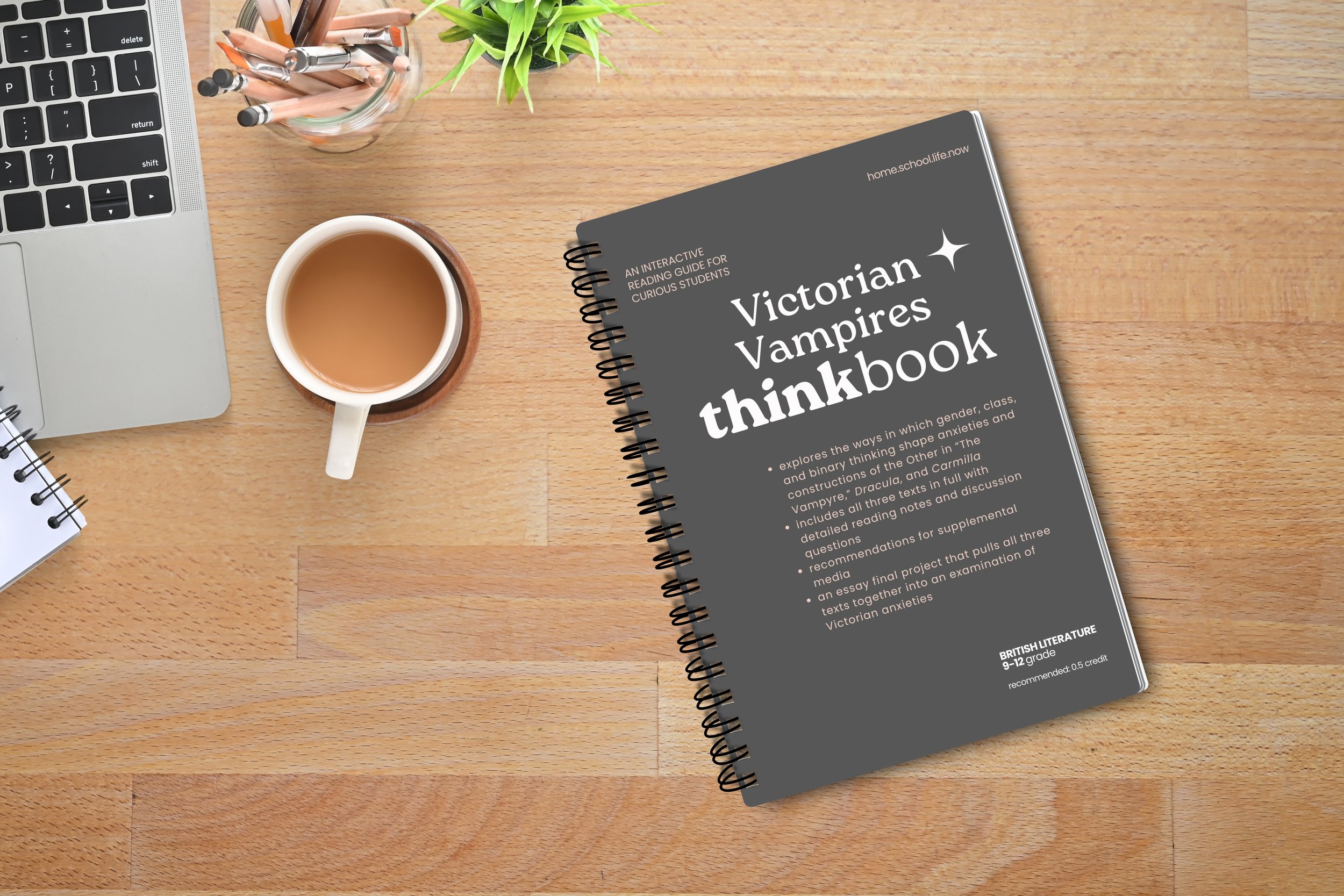
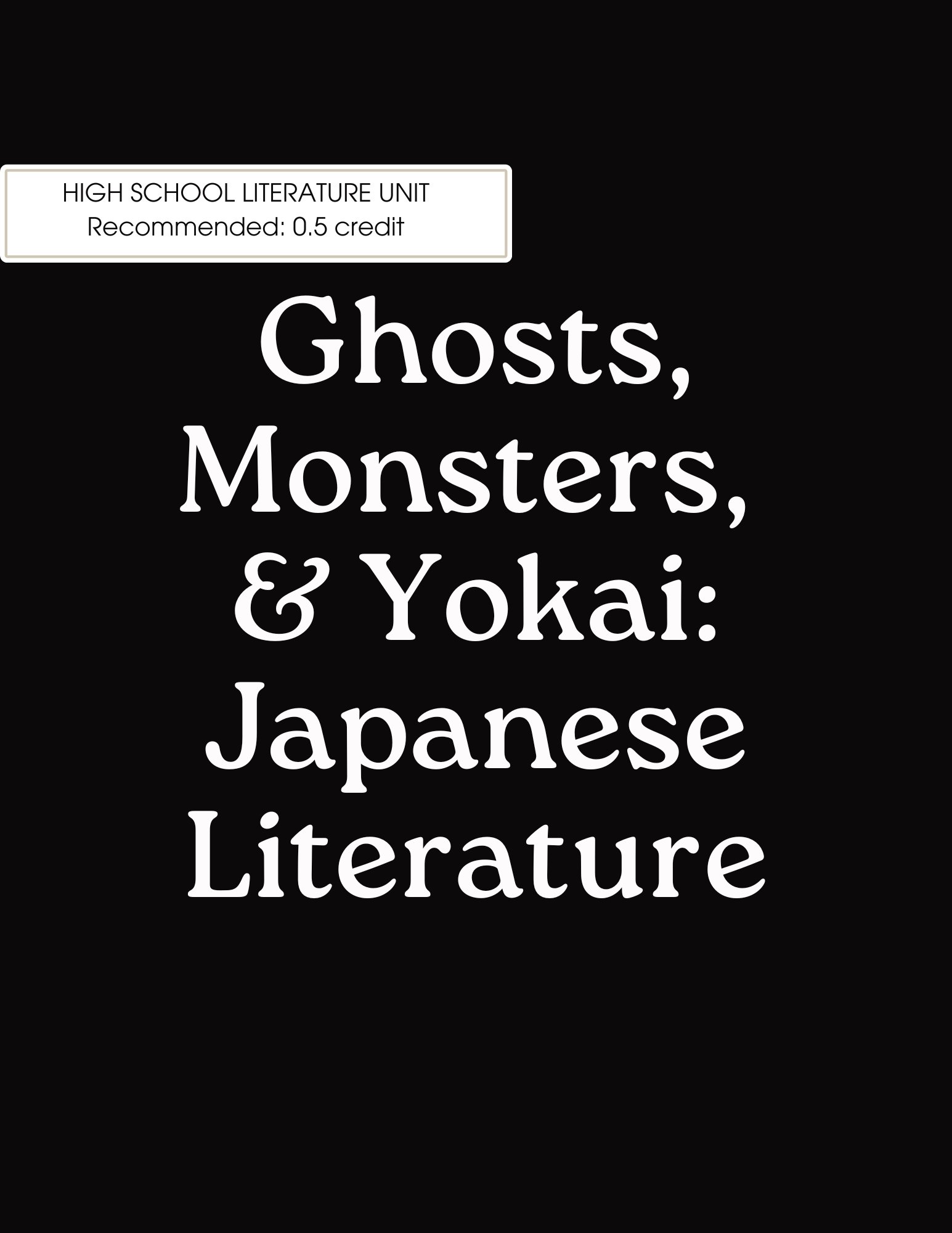
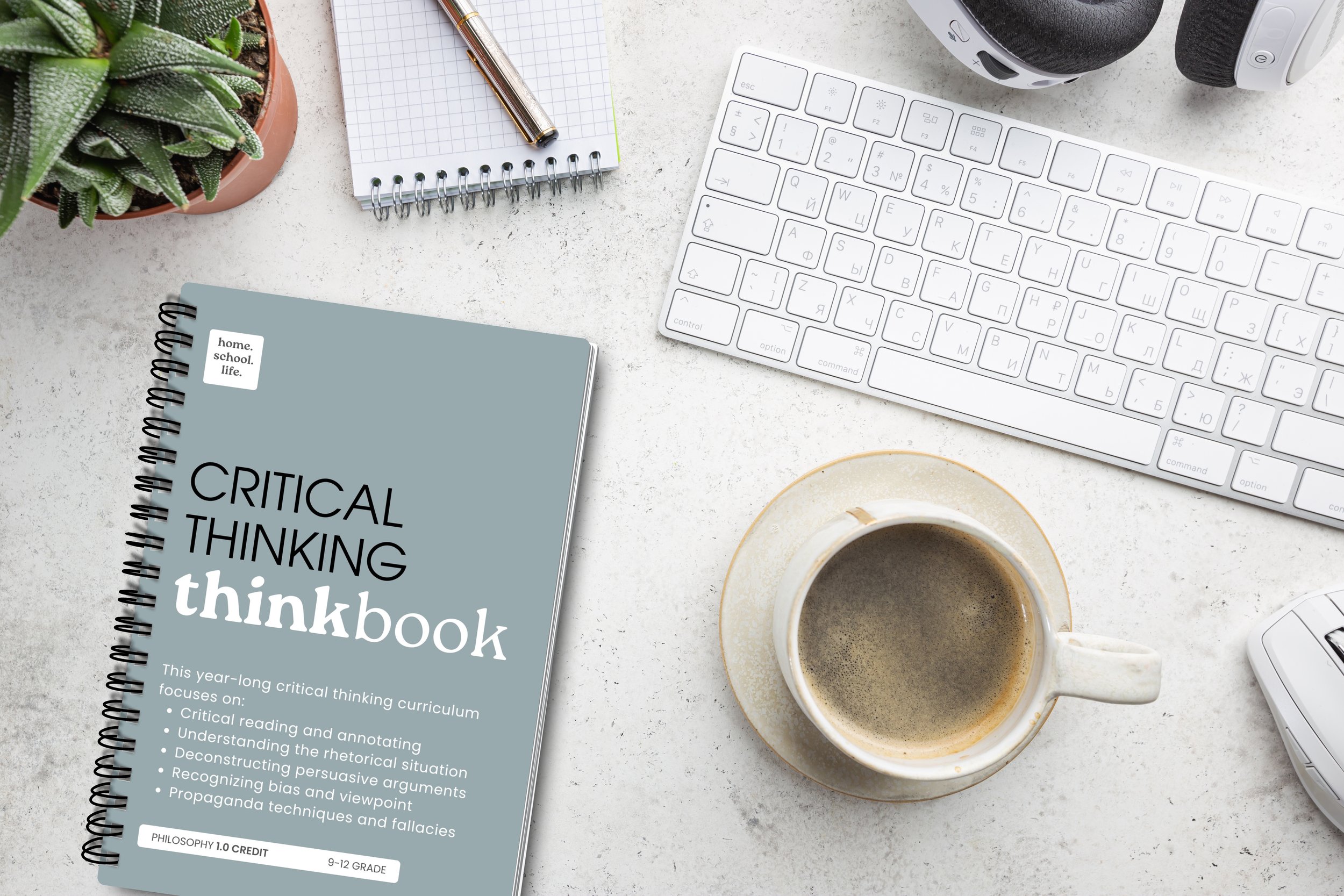
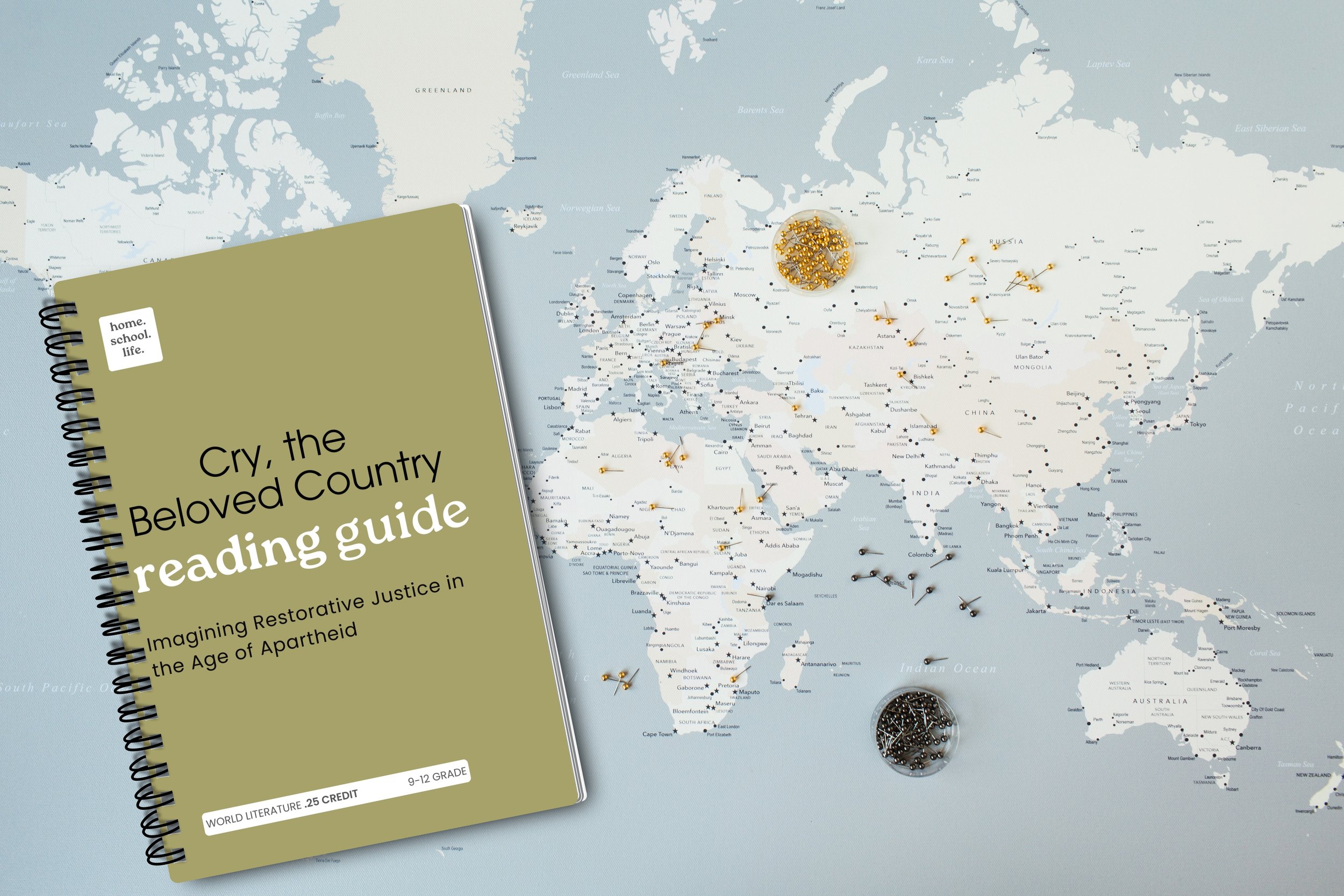



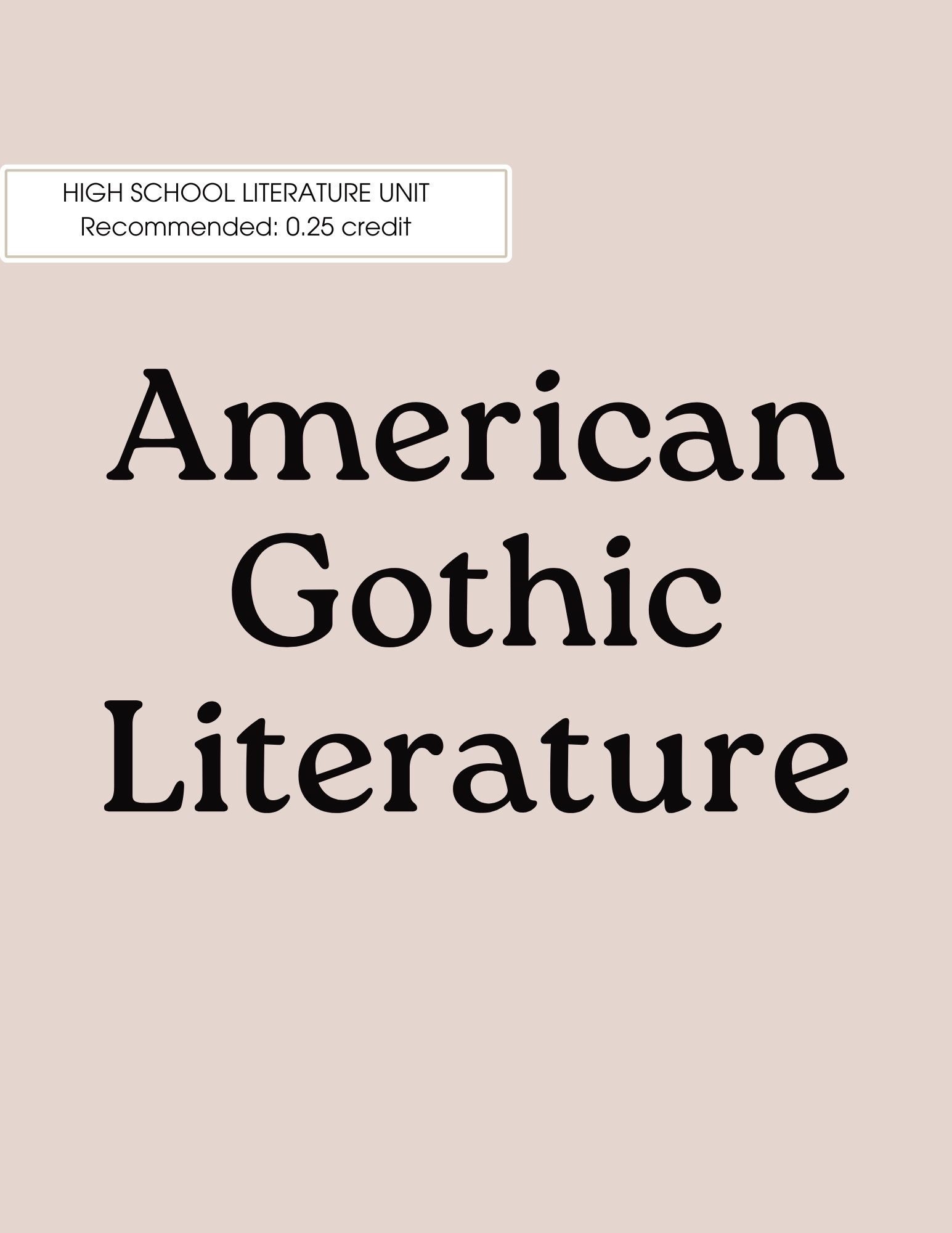
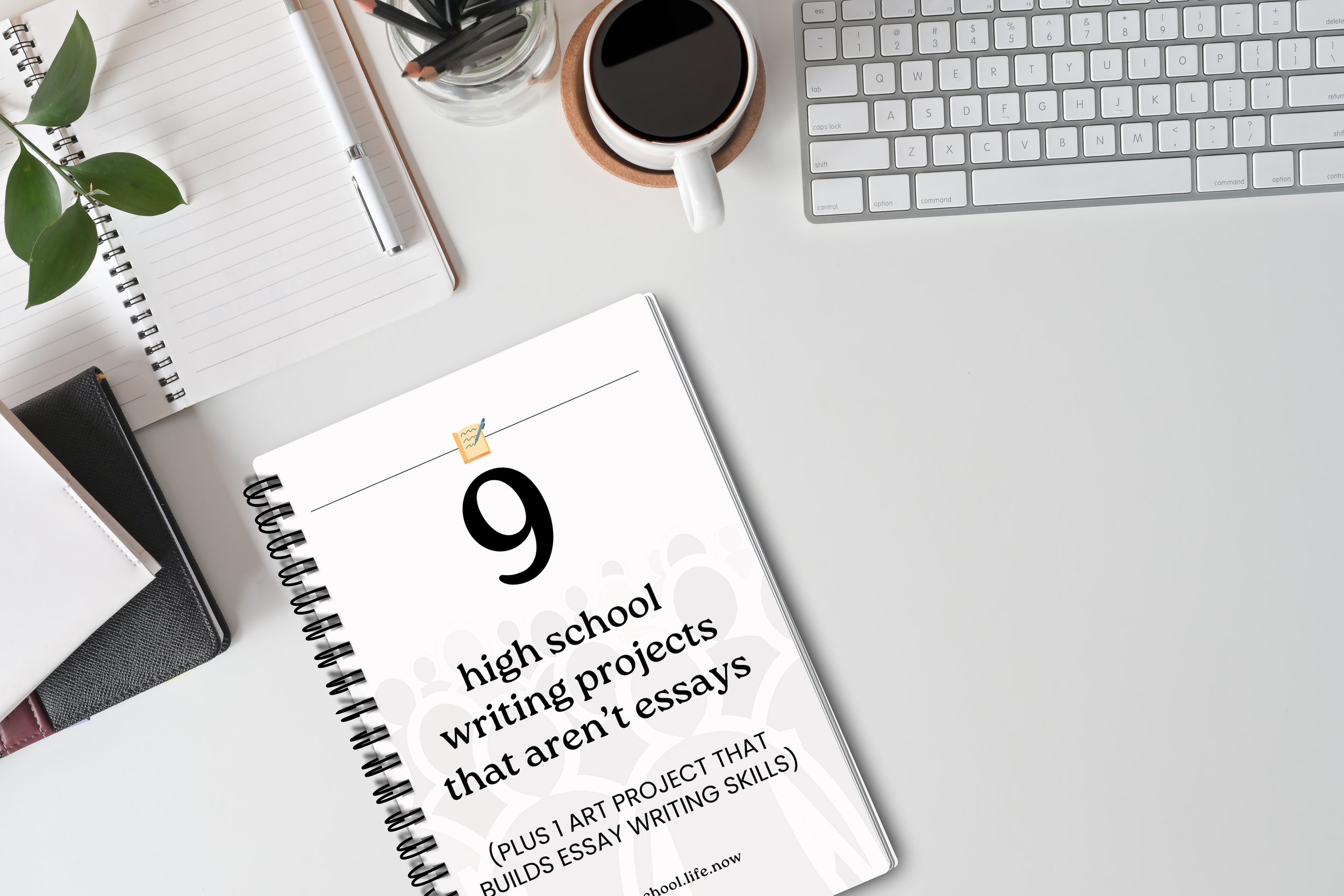


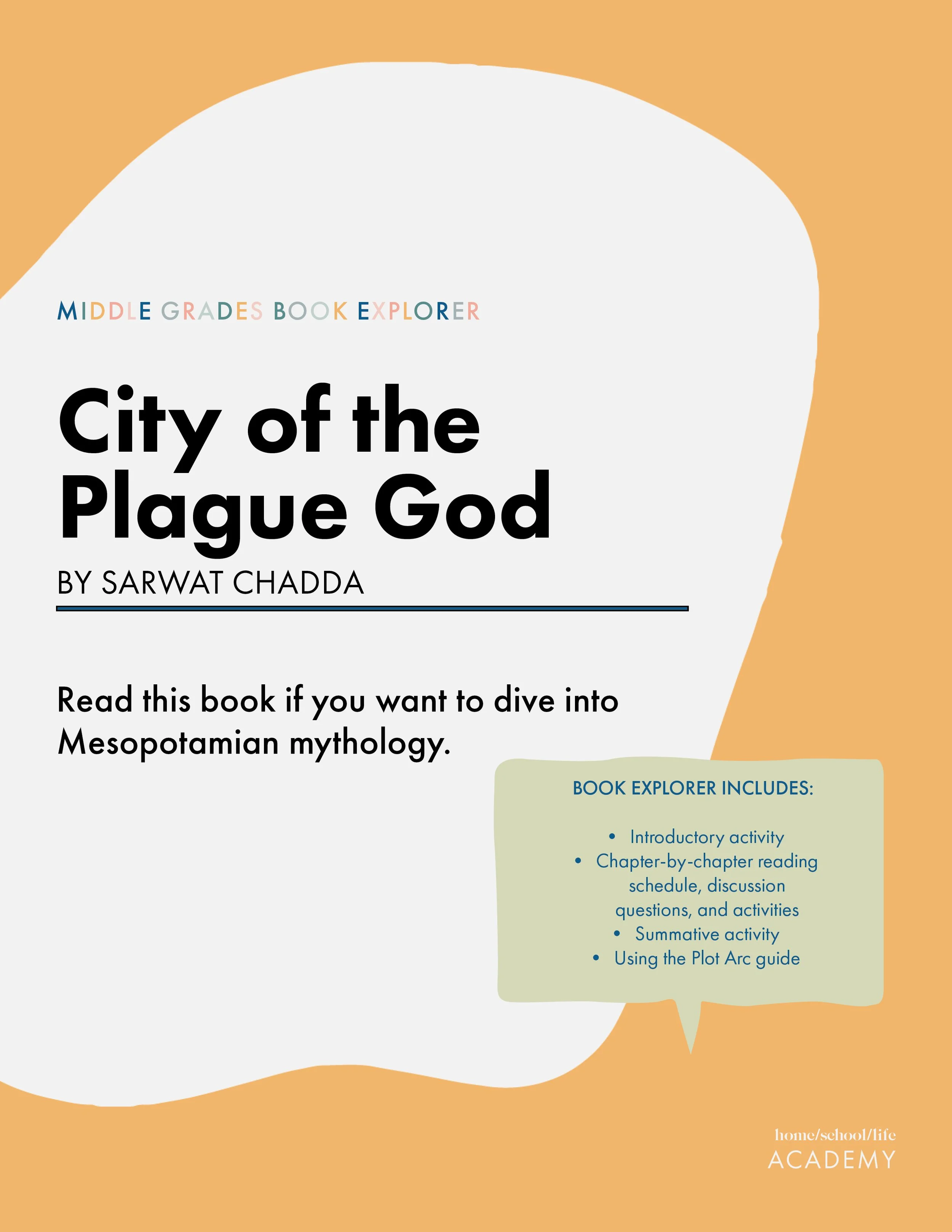


This is a digital product. It will be delivered via email as a PDF.
Our YEAR 1 curriculum focuses on the European world through two key periods of major historical change: the Enlightenment and the Victorian empire. We’ll explore the constantly changing cauldron of history, literature, philosophy, and geography of these periods with an emphasis on amplifying voices that have been historically marginalized. In science, we dive into Biology, focusing on evolutionary biology.
This is not a reading guide; it is a complete 28-week (400+-page) curriculum, including lessons, assignments, exams, lectures, and supplemental materials. It also includes strategies for planning, goal-setting, and evaluating (and assigning grades for) work. It is designed for the Academy’s two 14-week semesters, but I’ve included suggestions for adapting the pace for your particular homeschool. This curriculum is written for the student; there is no parent guide. (If you have questions or need support, please feel free to contact me!)
See a sample week here.
Listen to a sample lecture here.
INCLUDES:
Literature (Units: Satire, Inventing Genre, Novel Study, Victorian Poetry, Victorian Vampires, Sherlock Holmes and Detective Fiction, The Importance of Being Earnest)
History (Units:The Long 18th Century, Constructing Queen Victoria, Victorian Gender and Sexuality, Victorian Crime and Punishment)
Philosophy (Fundamentals of Critical Thinking)
Biology
Includes weekly student planner and goal setter. Add your own math and foreign language, and you’re all set!
In addition to this curriculum package, you will need to purchase or otherwise procure copies of: Gulliver’s Travels, The Importance of Being Earnest, Remarkable Creatures. All other required readings are included in this curriculum.
This is a high school level curriculum, designed for students who are already familiar with the basic elements of literature (plot, character, theme, setting, etc.) and who are comfortable applying those skills to texts. Like most high school level curricula, it includes works that could be rated M for Mature. If mature content is a concern for you with your student, I encourage you to preview texts to asses your personal comfort level. (I read these texts with my own high school student and teach them in high school classes, but comfort levels can be very personal things.) This is a completely secular program.
With both print and digital curriculum, primary source documents and other readings are included in the curriculum. Please see the sample curriculum pages to see how this looks!
You will need to provide supplies for your science labs — we’ve included a list for each one. To use online lectures and materials, you will need access to a computer and the internet.
You do not need to use this curriculum in order. If you want to start with the curriculum we call Year 3, you can absolutely use that for your first year. Our curriculum is set up so that your grades and evaluations reflect student progress — that means you’re interested in how your student grows and develops as a learner from year to year instead of focusing on arbitrary metrics.
You should be aware: No curriculum is unbiased, but ours is intentionally progressive. We believe in decolonizing the curriculum, and our program is unapologetically against racism, sexism, homophobia, xenophobia, and othering in all its forms. There may have been a time when curriculum could be neutral, but to be neutral within these systems is to support oppression — and we cannot do that. If you want a curriculum that presents the “other side” of things like evolution or sexism, we are probably not the best choice for your homeschool.
Because of the nature of digital publications, all sales are final. If you have questions, please ask before you buy!